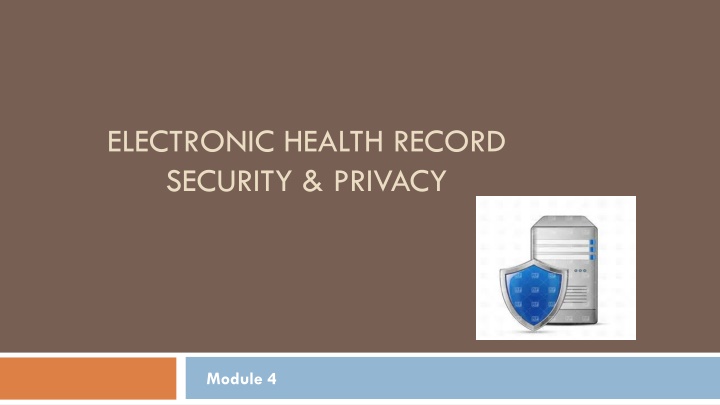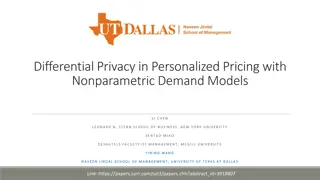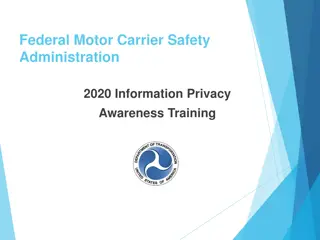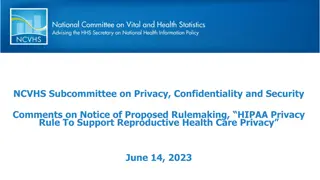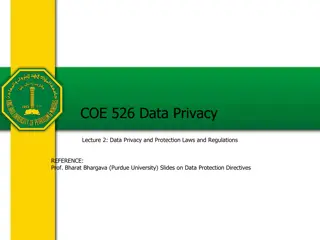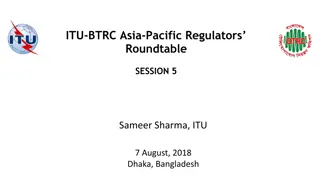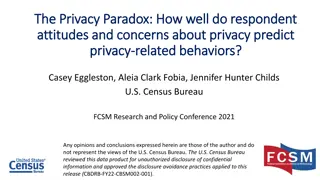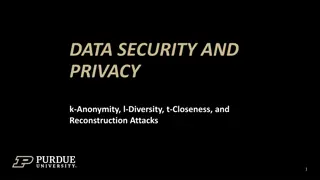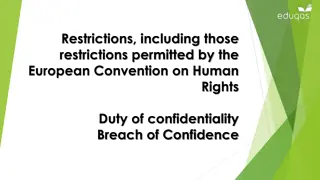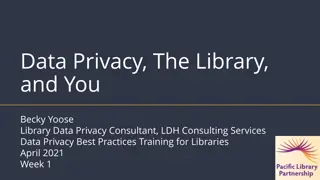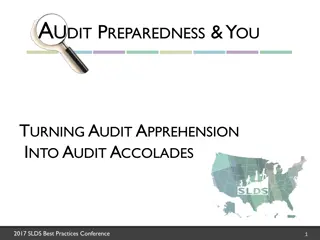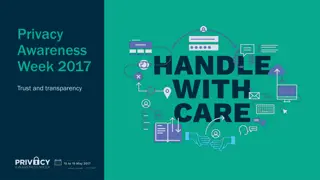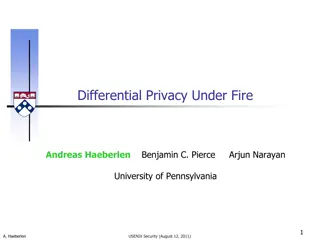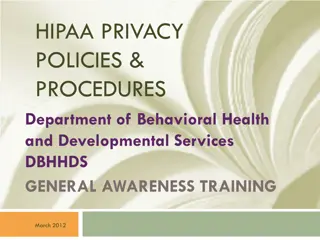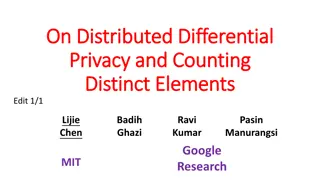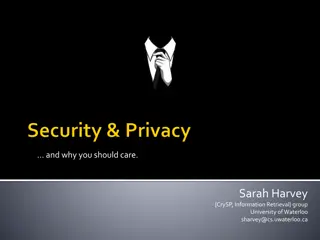Electronic Health Record Security & Privacy Module Overview
This course covers Health IT Privacy and Security, including HIPAA rules, safeguards in place, identifying information security, compliance with HIPAA, and more. Learn about the importance of privacy and security in protecting patient information.
Download Presentation

Please find below an Image/Link to download the presentation.
The content on the website is provided AS IS for your information and personal use only. It may not be sold, licensed, or shared on other websites without obtaining consent from the author.If you encounter any issues during the download, it is possible that the publisher has removed the file from their server.
You are allowed to download the files provided on this website for personal or commercial use, subject to the condition that they are used lawfully. All files are the property of their respective owners.
The content on the website is provided AS IS for your information and personal use only. It may not be sold, licensed, or shared on other websites without obtaining consent from the author.
E N D
Presentation Transcript
ELECTRONIC HEALTH RECORD SECURITY & PRIVACY Module 4
Introduction This course provides an overview of Health IT Privacy and Security. It includes information on the HIPAA Privacy & Security Rules and the safeguards that are in place to be in compliance with these rules.
Learning Outcomes Upon completion of the module the learner will be able to: Discuss HIPAA s Privacy & Security Rules List specific types of identifying information that need to be kept secure Give examples of the Administrative, Physical, and Technical safeguards that help to protect sensitive patient information Realize how you and your organization are compliant with HIPAA Understand compliance plans and policies, data breaches
What is HIPAA? HIPAA is the Health Insurance Portability and Accountability Act of 1996 Federal act with guidelines for standardizing the electronic data interchange of administrative and financial healthcare transactions, exposing fraud and abuse, and protecting and securing PHI Protects private health information, ensures coverage, uncovers fraud and abuse, and creates industry standards Portability allows Americans to continue their health insurance coverage upon termination of a job to bridge the gap until they are able to secure coverage with their new employer Accountability is to enhance the confidentiality and privacy of personal medical records
Privacy vs. Security Privacy is the right of an individual to keep his/her individual health information from being disclosed without their authorization Security is how we protect PHI from accidental or intentional disclosure, alteration, destruction or loss. This includes how we store, maintain and transmit information about our patients
Privacy Rule vs. Security Rule The Privacy Rule sets the standards for, among other things, who may have access to Protected Health Information (PHI), while the Security Rule sets the standards for ensuring that only those who should have access to Electronic Protected Health Information (EPHI) will actually have access.
Who must comply Covered Entities Health Care Providers Health Plans Health Care Clearinghouses Covered entities include every member of the workforce regardless of job title: Full time employees Interns/externs Physicians Part time employees Volunteers Nurses
Who must comply Business Associates Business associate (BA) Organizations that work for covered entities but are not themselves Covered Entities (law firms; outside medical billers, coders, and transcriptionists; collection agencies; accountants)
PHI/EPHI What we have to keep private and secure HIPAA protects an individual s health information and his/her demographic information. This is called protected health information or PHI , in an electronic format it is referred to as EPHI . PHI/EPHI consists of: Health information related to past, present, or future physical or mental health of the individual. Descriptions of a disease, diagnosis, procedure, prognosis, or condition of the individual and can exist in any voicemail, email, fax or verbal or written communications.
What is Individually Identifiable Health Information (IIHI) Anything that can possibly identify a patient is considered IIHI Patient Names Patient Addresses Patient Telephone Numbers Social Security Numbers Health Insurance Policy Numbers Medical Record Numbers Photographs Fingerprint and Voice Files
HIPAAs Minimum Standard Rule Must provide only PHI in the minimum necessary amount to accomplish the intended purpose of use or disclosure Does not apply when patient provides a valid, signed authorization of release of PHI
Privacy Rule: Patient Rights To receive a copy of the organization s Notice of Privacy Practices (NPP) our HIPAA policy To review their medical record and receive a copy upon request Receive an Accounting of Disclosures To request amendments to their record to correct errors or add missing information To restrict access to their record To file a complaint if they feel their privacy has been compromised
Security Rule: Administrative Safeguards Administrative Safeguards Administrative safeguards refer to the policies and procedures that exist in healthcare to protect the security, privacy, and confidentiality of your patient s PHI/EPHI.
Security Rule: Physical Safeguards Physical Safeguards: Physical safeguards for PHI/EPHI and Health IT refer to measures to protect the hardware and the facilities that store PHI. Physical threats, whether in electronic or paper formation, affect the security of health information. Some of the safeguards for electronic and paper-based systems are similar, but some safeguards are specific to health IT.
Security Rule: Technical Safeguards Technical Safeguards: Technical safeguards are safeguards that are built into your health IT system to protect health information and to control access to it. This includes measures to limit access to electronic information, to encrypt and decrypt electronic information, and to guard against unauthorized access to that information while it is being transmitted to others.
CompliancePlans In order to ensure that an organization is compliant with the Privacy & Security Rules in HIPAA they must have compliance plans in place. Create policies and procedures Establish the structure to adhere to those policies Set up a monitoring system to ensure compliance Correct conduct that does not comply
Compliancepolicies should address: Notice of Privacy Practices ensuring that all new patients are offered a copy Shredding of document that include PHI any hard copy that can identify a patient must be shredded, not thrown in the trash Positioning of computer monitors computer screens should not be seen by someone walking down the hall way or in a common area
Compliancepolicies should address: (continued) Placement of paper medical records medical records should not be left where someone could see the name on the record Password sharing all employees must have their own unique username and password in order to ensure data integrity Proper use of email business email should be used for business purposes, not personal
Compliancepolicies should address: (continued) Staff education education should occur at orientation for new employees and annually for all employees Printing policies documents that are appropriate to print Security audits periodic audits of user activity to evaluate proper use and access of patient information Virus protection management of database to ensure outside viruses or malware are not infecting patient data
Compliance policies should address: (continued) Faxing all faxes must have a cover page which states the organization s policy if the fax was sent to the wrong recipient Proper identification of patient must identify the patient is who they say they are whether in person or on he phone Social Media pictures, comments about patients, your employer, should never appear on your Social Media i.e., Facebook, Instagram, SnapChat Posts are never permanently deleted and may result in your termination or worse!
Fines & Penalties What is a Data Breach? The unauthorized acquisition, access, use, or disclosure of PHI which compromises the security or privacy of such information Releasing any of patients information without authorization Consequences: Federal fines of $100 per accidental violation Maximum fine of $250,000 for malicious violation Federal prison sentence up to 10 years for selling PHI or using with intent to harm someone You can be personally liable!
Summary You have learned about: The Health Information Portability and Accountability Act (HIPAA) - Privacy & Security Rule Security and privacy safeguards of the EHR including o Administrative Safeguards o Physical Safeguards o Technical Safeguards Data Breaches & Consequences Ways in which healthcare workers can protect the privacy of sensitive healthcare information Ways in which healthcare workers can secure the EHR
Acknowledgements 24 This curriculum was developed with grant funding from The Healthcare Workforce Transformation Fund through the Commonwealth of Massachusetts, Executive office of Labor and Workforce Development. The grant project was administered by Commonwealth Corporation and The Massachusetts eHealth Institute.
